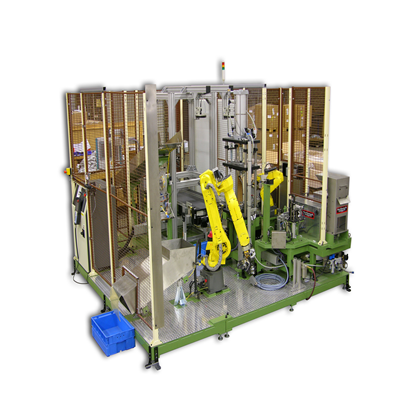Automated Assembly Systems
ABCO is an industry leader in factory automation fueled by robots for manufacturing companies, leading to higher productivity, lower costs, increased worker safety, and improved quality.

Automated Assembly Systems
Automated assembly technology revolutionizes manufacturing by employing robotics and advanced control systems to streamline processes. This technology enables precise, efficient assembly of complex products, increasing production rates and ensuring consistent quality. Equipped with sensors and vision systems, automated systems ensure accurate component placement and alignment, minimizing errors and rework.
These systems integrate seamlessly into existing production lines, enhancing flexibility for manufacturers to adapt quickly to new product designs and market demands. Automated assembly also enhances workplace safety by handling repetitive and hazardous tasks, contributing to more efficient and sustainable manufacturing operations.
Automated Assembly Systems Use In Manufacturing
Automated assembly systems play a crucial role in optimizing production lines and ensuring high-quality output in manufacturing. These systems utilize robotics and precise control mechanisms to manage complex assemblies with minimal human intervention. Equipped with advanced sensors and vision systems, automated assembly ensures accurate component placement, alignment, and fastening, reducing errors and rework.
Integration with CAD/CAM software facilitates seamless programming and adjustments for quick transitions between product configurations. High-speed conveyors and robotic arms boost throughput, while precision torque tools and automated inspection stations maintain consistent assembly quality. Advanced data analytics and machine learning algorithms enable predictive maintenance and performance optimization, further enhancing efficiency and sustainability in manufacturing operations.
Advantages of Automated Assembly Systems
Automated assembly systems and processes provide the following advantages:
- Increased Speed: Enhances throughput with faster operations.
- Consistent Quality: Ensures uniformity, reducing errors and defects.
- Cost Efficiency: Lowers labor costs and minimizes material waste.
- Flexibility: Adapts quickly to different products and designs.
- Improved Safety: Reduces workplace injuries by handling hazardous tasks.
Areas Where Automated Assembly is Used
Many industries and processes use automated assembly systems:
- Packaging machinery assembly
- Textile and garment production
- Agricultural machinery manufacturing
- Food and beverage lines
- Pharmaceutical packaging systems
For more information on how ABCO can help you automate your assembly process, please contact us.
.png2.png)

.png2.png)
ABCO Integrates Robots
ABCO has many years of experience in developing and implementing robotic systems. We can provide any form of robotic automation ranging from application evaluations to individual cells to turnkey solutions. ABCO will work provide you a solution based on your stated goals. We work with the best robot manufacturers in the industry and can help you pick out the right robot(s) for your needs.
Benefits of Robot Automation
Factory automation fueled by robots provides many benefits to manufacturing companies, including higher productivity, lower costs, increased worker safety, and improved quality.
Lower Costs
With robotic systems, manufacturers can experience faster manufacturing times and increased efficiencies, which translates into producing more product in a timely manner. Over time those improved efficiencies lead to cost savings due to reduced waste, lower operational expenses, and decreased hands-on labor.
Employee Safety
Employees reap the bulk of the automation rewards. Robots can work in challenging environment, including hot, very cold, and very hazardous areas, so workers are to be exposed to any of those conditions. In addition, employees can be moved from performing tedious labor-intensive tasks to assignments that offer more engaging responsibilities.
Improved Quality
Additionally, manufacturers can see improved quality due to consistent product fabrication and quality control systems that use vision systems to continually check for defects.





